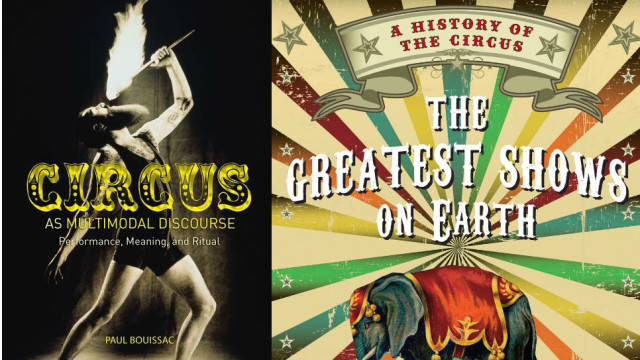*Originally written for academic journal, Theatre Research International*
These two volumes approach the subject of circus in full acknowledgement of its mythic status in popular culture. Simon presents her history of the most well reported performers and organizations of the last 250 years through the lens of their influence and impact on other artists’ work, with particular reference to the visual arts and literature. Semiotician Bouissac explores ways in which the viewer can step behind the curtain of pop-cultural expectations and look deeper into the layers of meaning and symbolism at play in any circus production.
The semiotic concept of multimodality has long been recognized and examined by academics in the fields of dance, theatre, literary and visual arts, acknowledging that the formation of any artistic work relies on combining various communicative languages and reference points to deliver its messages. Studies of circus, however, have largely been limited to historical reportage rather than investigations into artistic process and purpose. Bouissac’s decades-long circus career combines with his semiotic expertise, producing an elucidating guide to the precedents and developments of various circus acts and their hitherto unspoken modes of communication.
As a circus ethnographer, Bouissac presents ‘verbal renderings’ (p. 139) of numerous acts across the spectrum of acrobatics, clowning, and animal performance, which serve as both documentation and a window into deconstructing the communicative elements of each performance. Whilst the immediacy of a spectacle can be enjoyed at one level, a deeper appreciation of an art can be found through reflection and analysis, and Bouissac offers ways to conceive individual acts – and the overall composition of a circus production – as ‘a multilinear score’ (p. 96). Chapters examine the production and reception of circus performance in relation to ritual, the space of the ring, actions, storytelling, ideology, and physiology, augmented by photographs and etchings to illustrate descriptions of technique.
Bouissac’s diverse bibliography includes reference to texts on circus history and disciplines, anthropology, language, semiotics, animal behaviour and neurology, for it is through respect to all these areas of discourse that ‘the language of circus articulates its own multimodal text which produces a deep, albeit tacit meaning for its audience’ (p.187).
Simon’s book, in the more traditional vein of historical reportage, focuses on events and actions of certain performers and companies since the development of the modern Western circus form in the eighteenth century, and on the ways these have been interpreted by the prevailing culture of their times. Each chapter takes a loosely chronological journey, crossing the Atlantic between Western Europe and North America, and the volume is illustrated throughout with paintings, photographs and circus posters.
Beginning with a potted history of examples of acts that would later come to be associated with the circus, Simon divides her chapters thematically: the development of trick riding; the establishment of circus buildings in Paris and the upper class cirques intimes; the US tenting business; parades; aerial performance; animal displays; clowns; feats of strength, contortion and juggling; the sideshow of ‘freaks’, or ‘prodigies’; the development of some modern incarnations of the circus ethos.
With no clear argument or conclusion drawn, this volume is a comprehensive voyeur’s guide to some of the most famous examples of circus history, in the company of those voyeurs from history whose responses to the art form have helped to forge the mythologies and cultural institution of circus as it is popularly perceived today. Revealing the connections held by painters to their circus subject and quoting regular passages from the work of novelists and essayists allows Simon to give life to the emotive and nostalgic magic that a circus experience can evoke. She maintains the historically popular tone that renders the circus lifestyle and the people who work within it as Edward Said’s romantic Other; the reader is invited to sit back and enjoy the show rather than get inside the musculature of the artform.
Simon’s book may provide a solid historical foundation to some of the most prominent developments of the modern circus format, but makes no attempt to engage with the living practise as Bouissac takes such care to do. Circus is an evolving, live art, not merely a historical curiosity and, in Bouissac’s work, it’s encouraging to find literature that takes an analytical approach to current performance work.
Bouissac, Paul. Circus As Multimodal Discourse: Performance, Meaning, and Ritual (London: Bloomsbury, 2014) ISBN: 978-1472569479
Simon, Linda. The Greatest Shows On Earth: A History of the Circus (London: Reaktion Books, 2014) ISBN: 978-1780233581







Circus Diaries is a basic reading guide for circus fans that look for high quality information and reflection about circus. For me it has been and amazing resource as a circus costume and makeup designer but also as a reasearcher of circus in Mexico.
Yay, my own review! Thanks 😀